在程序开发中, 一定遇到并发编程的场景, 虽然我们大部分时间并不直接使用Thread, 但是Thread是多线程的基础, 面试中也会总是被问到与线程有关的问题; 那么线程都有哪些知识呢? 最近在研究线程的源码的时候也总结了关于线程一些基本知识;
线程是什么
线程是轻量级的进程, 是操作系统调度任务到CPU的最小单元;
多线程编程的优点
1、多线程编程能够最大程度的利用多核设备上面的CPU资源, 保证任务处理的足够快, 及时响应客户端的额请求
2、线程的创建的代价比创建进程的代价小很多, 同时多线程的上下文切换也更快; 《操作系统概念 第六版》 在Solaris 2上面, 创建进程比创建线程慢30倍, 而进程的上下文切换比线程的上下文切换慢5倍;
Java中线程的状态有哪些
查看java.lang.Thread的源码有如下代码:
public enum State {
/**
* Thread state for a thread which has not yet started.
*/
NEW,
/**
* Thread state for a runnable thread. A thread in the runnable
* state is executing in the Java virtual machine but it may
* be waiting for other resources from the operating system
* such as processor.
*/
RUNNABLE,
/**
* Thread state for a thread blocked waiting for a monitor lock.
* A thread in the blocked state is waiting for a monitor lock
* to enter a synchronized block/method or
* reenter a synchronized block/method after calling
* {@link Object#wait() Object.wait}.
*/
BLOCKED,
/**
* Thread state for a waiting thread.
* A thread is in the waiting state due to calling one of the
* following methods:
*
*
{@link Object#wait() Object.wait} with no timeout*
{@link #join() Thread.join} with no timeout*
{@link LockSupport#park() LockSupport.park}*
*
*
A thread in the waiting state is waiting for another thread to
* perform a particular action.
*
* For example, a thread that has called Object.wait()
* on an object is waiting for another thread to call
* Object.notify() or Object.notifyAll() on
* that object. A thread that has called Thread.join()
* is waiting for a specified thread to terminate.
*/
WAITING,
/**
* Thread state for a waiting thread with a specified waiting time.
* A thread is in the timed waiting state due to calling one of
* the following methods with a specified positive waiting time:
*
*
{@link #sleep Thread.sleep}*
{@link Object#wait(long) Object.wait} with timeout*
{@link #join(long) Thread.join} with timeout*
{@link LockSupport#parkNanos LockSupport.parkNanos}*
{@link LockSupport#parkUntil LockSupport.parkUntil}*
*/
TIMED_WAITING,
/**
* Thread state for a terminated thread.
* The thread has completed execution.
*/
TERMINATED;
}
1、NEW: 线程还没有启动的时候, 状态就是NEW 即 新建状态
2、RUNNABLE: 当一个线程处于运行中或者等待CPU调度的时候, 状态就是 RUNNABLE状态; 有些地方也称为 就绪状态
3、BLOCKED: 当一个线程在等待别的线程释放锁资源的时候, 状态就是BLOCKED, 或者在该线程获取到锁之后, 在同步代码块里面调用了Wait方法, 这时候释放锁, 在获取到其他线程的notify或者notifyAll通知之后, 重新进入 同步代码块这段时间 该线程也是BLOCKED状态的;
4、WAITING: 当正在运行的线程调用了Object.wait()方法 或者 Thread.join()方法 或者 LockSupport.park()方法之后, 会进入到WAITING状态
5、TIMED_WAITING: 当正在运行的线程调用Object.wait(n) 或者 Thread.join(n) 或者 LockSupport.parkUntil(blocker, n) 会进入到 TIMED_WAITING 状态
6、TERMINATED: 当线程结束后, 会进入到 TERMINATED 状态.
状态转换如下, 该图中比Java的状态多了一个RUNNING状态, 来区别 线程的就绪状态 与 运行状态 更加方便读者理解;
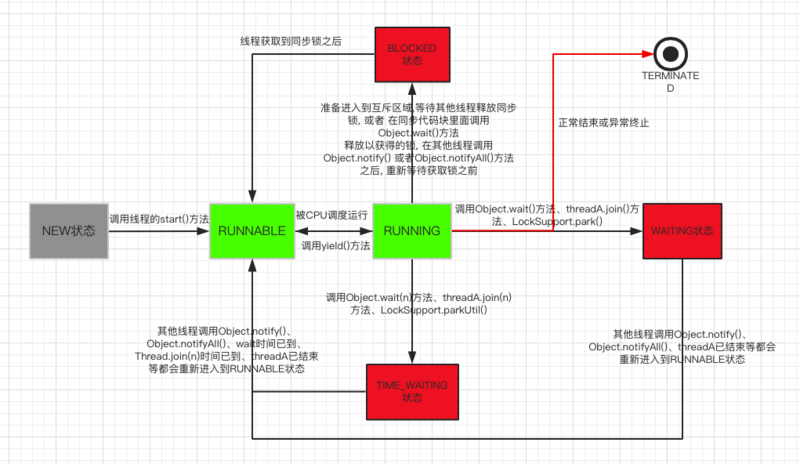
线程状态转换
线程状态转换之NEW
下面来看一下线程的状态转换用Java怎么实现:
如上面所述: 刚刚创建的线程处于NEW状态, 那么我们可以通过如下代码打印其状态:
Thread thread = new Thread(new Runnable() {
public void run() {
}
});
System.out.println(thread.getState());
线程状态转换之RUNNABLE
那么线程如何进入到RUNNABLE状态呢? 调用Thread的start方法即可; 我们在Runnable的实现里面增加对于当前线程状态的打印即可:
public static void main(String[] args) {
Thread thread = new Thread(new Runnable() {
public void run() {
System.out.println("线程进入:" + Thread.currentThread().getState());
}
});
System.out.println(thread.getState());
thread.start();
}
线程状态转换之TIMED_WAITING
那么线程怎么进入到TIMED_WAITING状态呢? 通过调用 sleep(n) join(n) 或者 wait(n)都可以进入到TIMED_WAITING状态:
调用Thread.sleep()
public static void main(String[] args) {
Thread thread = new Thread(new Runnable() {
public void run() {
System.out.println("线程进入:" + Thread.currentThread().getState());
try {
Thread.sleep(1000 * 60);
} catch (InterruptedException e) {
e.printStackTrace();
}
}
});
System.out.println(thread.getState());
thread.start();
}
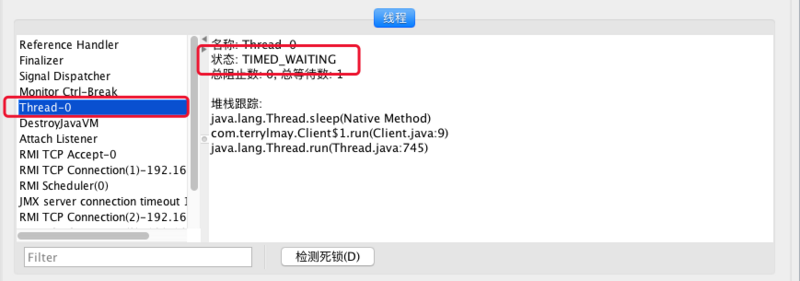
调用obj.wait(time)
public static void main(String[] args) {
Thread thread = new Thread(new Runnable() {
public void run() {
synchronized (Client.class) {
System.out.println("线程进入:" + Thread.currentThread().getState());
try {
Client.class.wait(60 * 1000);
} catch (InterruptedException e) {
e.printStackTrace();
}
}
}
});
System.out.println(thread.getState());
thread.start();
}
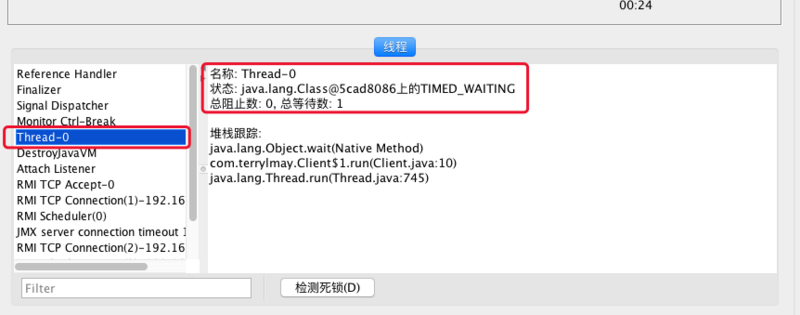
上图中表示: 在Client.class上面等待; 等待其他对象调用Client.class.notify()方法或者等待时间到期.
调用thread.join(time)
public static void main(String[] args) {
final Thread thread = new Thread(new Runnable() {
public void run() {
synchronized (Client.class) {
System.out.println("线程进入:" + Thread.currentThread().getState());
try {
Client.class.wait(60 * 1000);
} catch (InterruptedException e) {
e.printStackTrace();
}
System.out.println("Client.class对象上等待超时");
}
}
});
System.out.println(thread.getState());
thread.start();
Thread thread2 = new Thread(new Runnable() {
public void run() {
synchronized (Client.class) {
try {
thread.join(50 * 1000);
} catch (InterruptedException e) {
e.printStackTrace();
}
System.out.println("Thread1结束");
}
}
});
thread2.start();
}
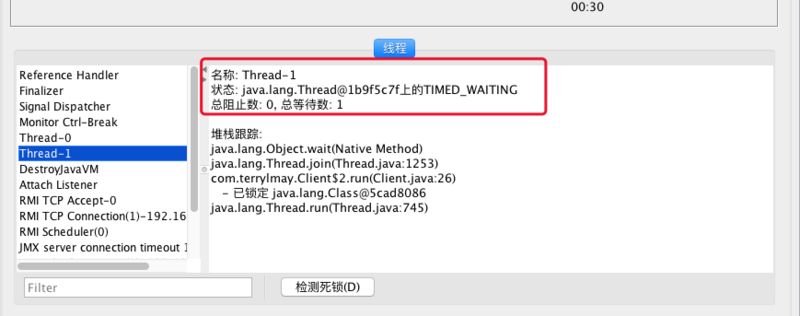
表示 第二个线程在等待第一个线程执行完成或者超时;
线程状态转换之WAITING
如果想要一个线程进入到WAITING状态, 那么只需要跟上面步骤一样, Thread.sleep()除外, 但是调用的时候不要传超时时间即可;
public static void main(String[] args) {
final Thread thread = new Thread(new Runnable() {
public void run() {
synchronized (Client.class) {
System.out.println("线程进入:" + Thread.currentThread().getState());
try {
Client.class.wait();
} catch (InterruptedException e) {
e.printStackTrace();
}
System.out.println("被其他线程调用Client.class.notify()唤醒");
}
}
});
System.out.println(thread.getState());
thread.start();
Thread thread2 = new Thread(new Runnable() {
public void run() {
synchronized (Client.class) {
try {
thread.join(50 * 1000);
Client.class.notify();
} catch (InterruptedException e) {
e.printStackTrace();
}
System.out.println("Thread1结束");
}
}
});
thread2.start();
}
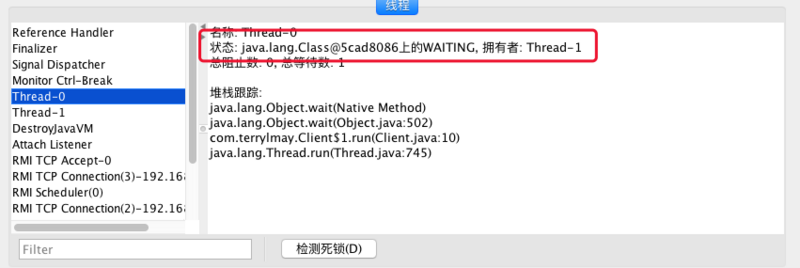
只要是没有时间的等待都会处于WAITING状态, 比如把上面代码修改一下, 换成join()也可以让线程处于 WAITING状态:
public static void main(String[] args) {
final Thread thread = new Thread(new Runnable() {
public void run() {
synchronized (Client.class) {
System.out.println("线程进入:" + Thread.currentThread().getState());
try {
Client.class.wait(50 * 1000);
} catch (InterruptedException e) {
e.printStackTrace();
}
System.out.println("被其他线程调用Client.class.notify()唤醒");
}
}
});
System.out.println(thread.getState());
thread.start();
Thread thread2 = new Thread(new Runnable() {
public void run() {
synchronized (Client.class) {
try {
System.out.println("即将进入等待线程1完成的状态");
thread.join();
} catch (InterruptedException e) {
e.printStackTrace();
}
System.out.println("Thread1结束");
}
}
});
thread2.start();
}
如上代码表示线程2会在线程1执行结束之后再结束, 所以线程2就会进入到WATIING状态
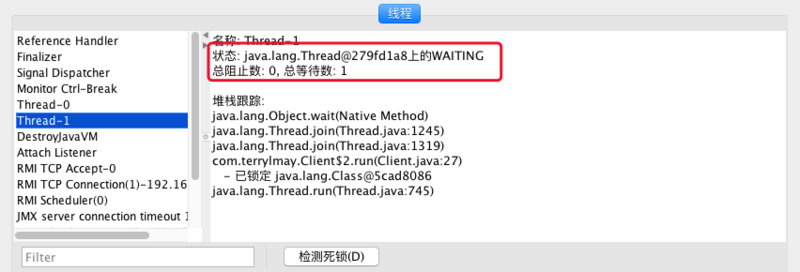
线程状态转换之BLOCKED
上面已经看到, 通过调用线程的函数就可以控制线程的状态, 那么如何进入到BLOCKED状态呢?进入到BLOCKED状态, 按照上面的转换图 可以翻译为 多个线程出现竟态的时候, 其他线程会进入BLOCKED状态, 只有一个线程会在RUNNABLE状态,比如如下代码:
public static void main(String[] args) {
final Thread thread = new Thread(new Runnable() {
public void run() {
synchronized (Client.class) {
System.out.println("线程进入:" + Thread.currentThread().getState());
try {
Thread.sleep(1000 * 50);
} catch (InterruptedException e) {
e.printStackTrace();
}
}
}
});
System.out.println(thread.getState());
thread.start();
Thread thread2 = new Thread(new Runnable() {
public void run() {
synchronized (Client.class) {
try {
System.out.println("即将进入等待线程1完成的状态");
thread.join();
} catch (InterruptedException e) {
e.printStackTrace();
}
System.out.println("Thread1结束");
}
}
});
thread2.start();
}

当然, 对于A线程调用了Object.class.wait()方法释放锁之后, 最后被其他线程调用Object.class.notify() A线程再次进入RUNNABLE之前的状态就是 BLOCKED;




















 636
636

 被折叠的 条评论
为什么被折叠?
被折叠的 条评论
为什么被折叠?








